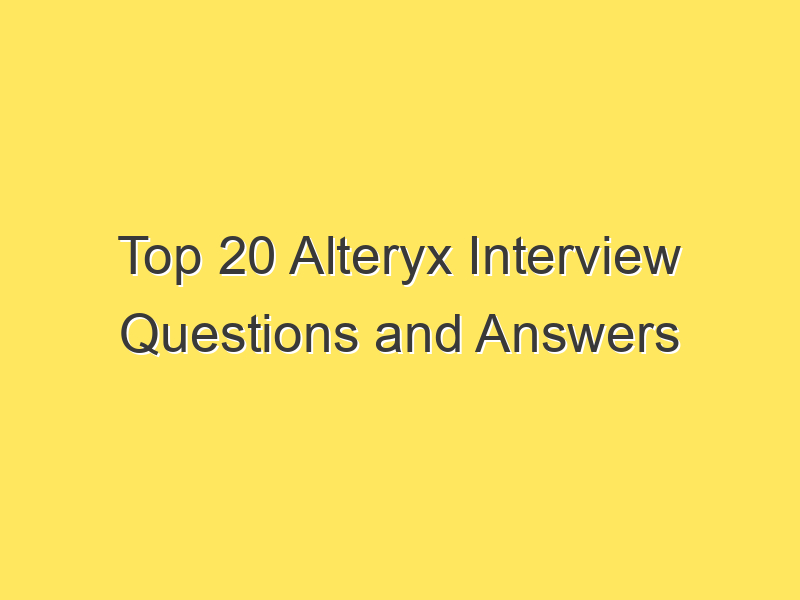H2O Interview Questions and Answers :
H2O is an open-source software for data analysis that provides a platform for building machine learning models. Whether you are a data scientist, analyst, or machine learning enthusiast, understanding H2O is crucial for harnessing the power of data. In this article, we’ll explore 10 common questions and answers about H2O, followed by an additional set of FAQs.
1. What is H2O? H2O is an open-source platform for data analysis that offers scalable machine learning capabilities. It is designed to work seamlessly with big data technologies, making it a popular choice for organizations dealing with large datasets.
2. How does H2O work? H2O utilizes distributed computing to process large datasets across multiple nodes. It supports various machine learning algorithms and allows users to build, train, and deploy models efficiently.
3. What programming languages does H2O support? H2O supports popular programming languages like R, Python, and Scala, making it accessible to a wide range of data professionals.
4. Can H2O handle big data? Yes, H2O is specifically designed to handle big data. It can scale horizontally, distributing computations across a cluster of machines to process large datasets efficiently.
5. What machine learning algorithms does H2O offer? H2O provides a rich set of machine learning algorithms, including but not limited to linear and generalized linear models, random forests, gradient boosting machines, deep learning, and more.
6. How is H2O different from other machine learning platforms? H2O distinguishes itself by its distributed computing capabilities, supporting big data processing. It also provides a user-friendly interface for model building and deployment.
7. Is H2O suitable for beginners in machine learning? Yes, H2O offers a user-friendly interface, making it accessible to beginners. It also provides documentation and tutorials to help users get started with building and deploying models.
8. Can H2O be used for real-time predictions? Yes, H2O supports real-time scoring, enabling users to deploy models for making predictions in real-time applications.
9. What industries use H2O for machine learning? H2O is used across various industries, including finance, healthcare, e-commerce, and more. Its scalability and versatility make it suitable for a wide range of applications.
10. How is model interpretability handled in H2O? H2O provides tools for model interpretability, allowing users to understand and explain the decisions made by machine learning models. This is essential for building trust in the model’s predictions.
FAQs:
Q1. Is H2O suitable for small datasets? Yes, while H2O is designed to handle big data, it is also effective for smaller datasets, providing flexibility for users with varying data sizes.
Q2. Can H2O be integrated with other data science tools? Yes, H2O can be integrated with popular data science tools and platforms, allowing users to leverage their existing workflows.
Q3. Are there any cloud-based options for using H2O? Yes, H2O can be used on cloud platforms like AWS, Azure, and Google Cloud, providing flexibility for users who prefer cloud-based solutions.
Q4. Does H2O offer support for time-series analysis? Yes, H2O provides features and algorithms specifically designed for time-series analysis, making it suitable for forecasting and predictive modeling.
Q5. How does H2O handle missing data? H2O includes methods for handling missing data, providing options for imputation and ensuring robust model training.
Q6. Can H2O be used for unsupervised learning tasks? Yes, H2O supports unsupervised learning algorithms, allowing users to perform tasks like clustering and dimensionality reduction.
Q7. What is the community support like for H2O? H2O has an active and growing community, with forums, documentation, and community-contributed resources that users can leverage for support.
Q8. How frequently is H2O updated? H2O has regular updates, with the development community actively contributing to improvements, bug fixes, and the addition of new features.
Q9. Is H2O suitable for real-time stream processing? Yes, H2O supports real-time stream processing, enabling users to build models that can analyze and make predictions on streaming data.
Q10. Can H2O models be deployed on edge devices? Yes, H2O provides options for deploying models on edge devices, extending its usability to scenarios with resource constraints.
In conclusion, H2O is a powerful tool for data professionals seeking scalable and efficient machine learning solutions. Its versatility, community support, and compatibility with various programming languages make it a valuable asset in the data science toolkit. Whether you are a beginner or an experienced data scientist, exploring H2O can open new possibilities for extracting insights and building predictive models from your data.






